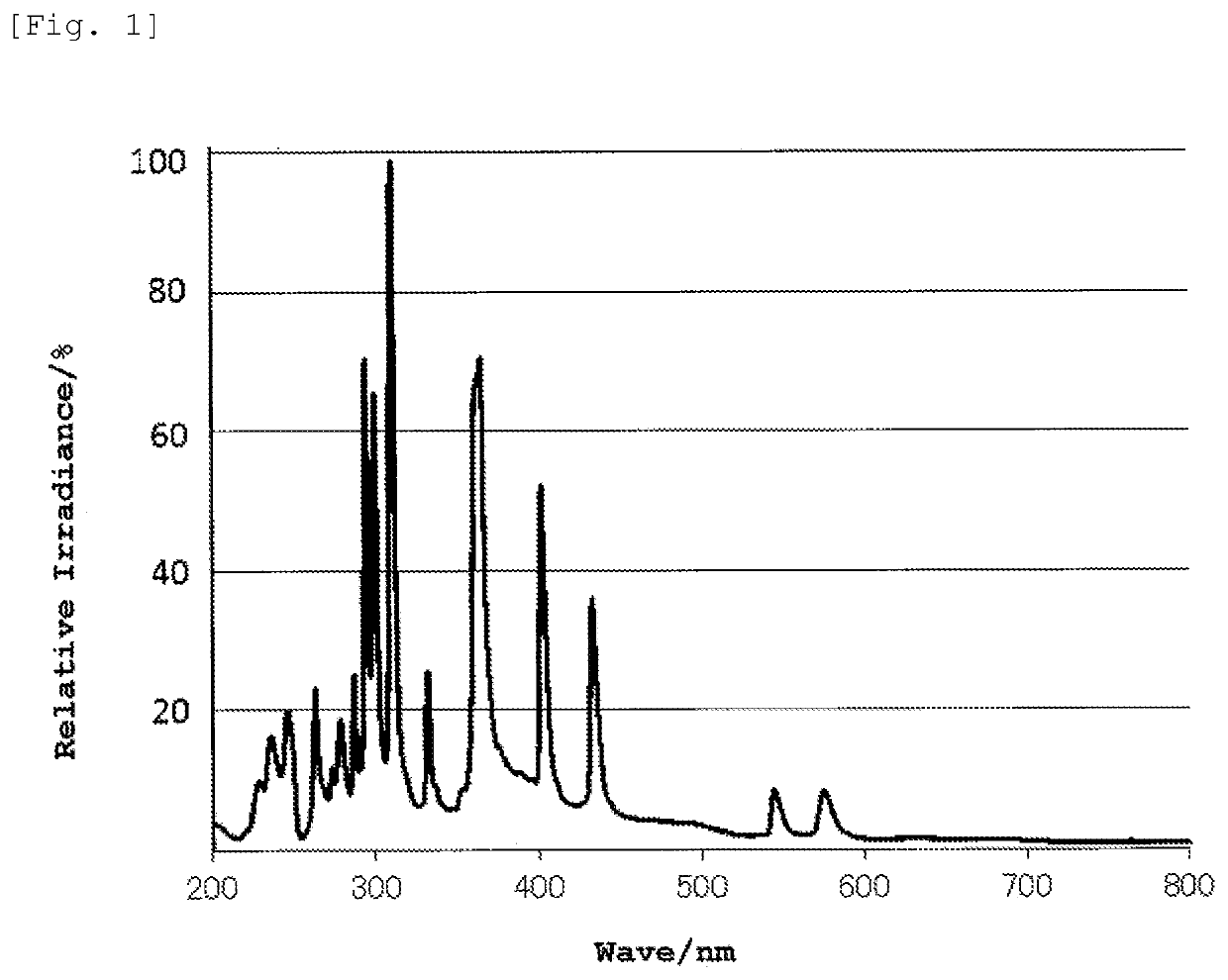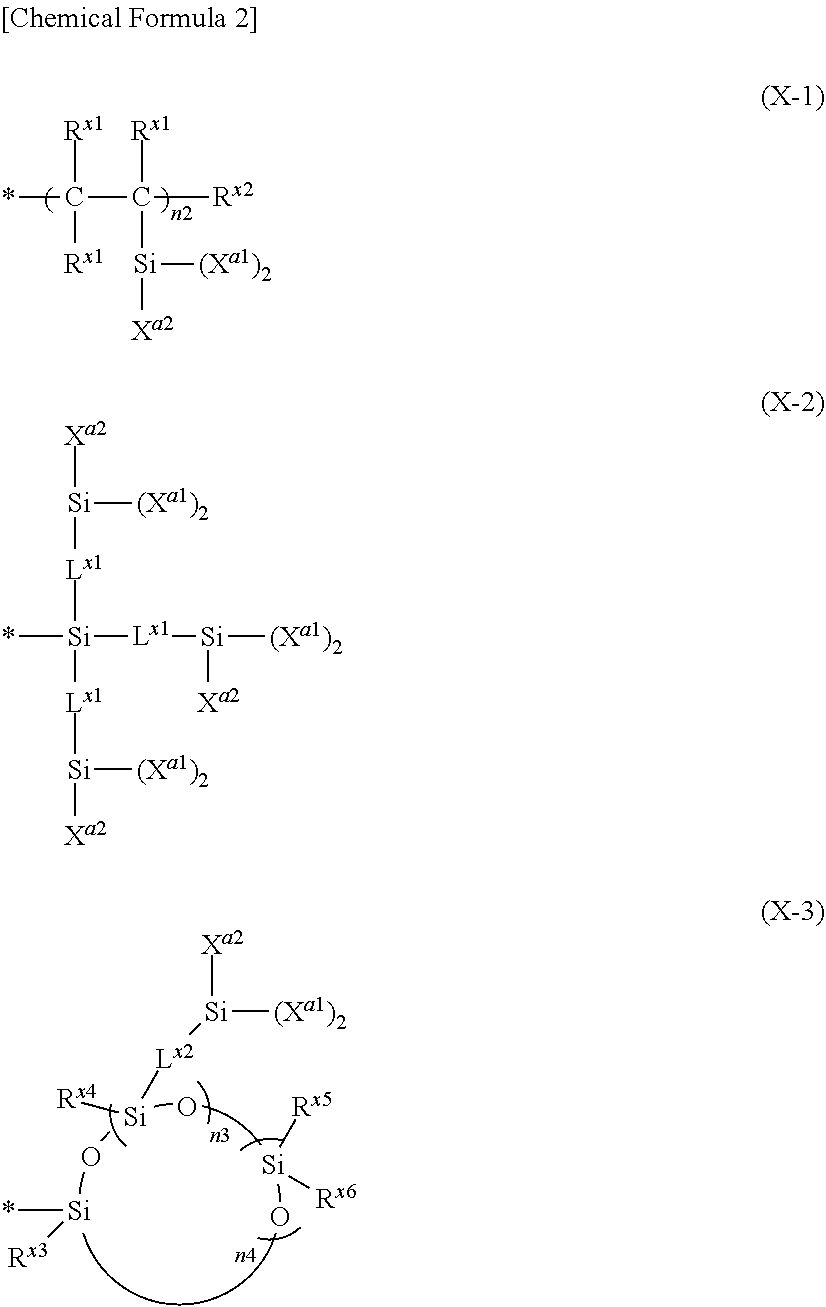Composition
a technology of composition and coating, applied in the direction of coatings, etc., can solve the problems of substrate corrosion and performance further deterioration, and achieve the effect of satisfactory heat resistance and light resistance, and water repellency
- Summary
- Abstract
- Description
- Claims
- Application Information
AI Technical Summary
Benefits of technology
Problems solved by technology
Method used
Image
Examples
synthesis example 1
[0235]A three-neck flask equipped with a condenser was charged with 3.94 g of trichloroisocyanuric acid and then purged with nitrogen. Dichloromethane (50 mL) was charged into the flask through a septum, followed by stirring and the addition of 5.0 g of tris(trimethylsiloxy)silane. After stirring for 1 hour, the mixture was filtered. The filtrate was added dropwise while being cooled in an ice bath charged with 150 mL of diethyl ether, 50 mL of ion-exchanged water, and 1.87 g of triethylamine. The mixture was stirred at room temperature for 1 hour. The mixture was washed with ion-exchanged water, dehydrated over magnesium sulfate, and concentrated at 25° C. under 150 mmHg to obtain 5.8 g of the objective silanol compound (1) represented by the following formula.
[0236]The three-neck flask were charged with 1.56 g of the silanol compound (1) and 7.00 g of THF, followed by stirring. After cooling to −40° C., 3.13 mL of an n-BuLihexane solution (1.6 mol / L) was added dropwise. The temper...
synthesis example 2
[0240]In the same manner as in Synthesis Example 1, an intermediate (1) was obtained.
[0241]A four-necked flask was charged with 7.89 g of tetrakis(dimethylsilyloxy)silane, followed by ice cooling. A mixture prepared by mixing the intermediate (1) with 5 μL of a platinum(0)-1,3-divinyl-1,1,3,3-tetramethyldisiloxane complex solution was added dropwise. After stirring for 15 minute, the mixed solution was concentrated under 2 hPa at 30° C. After cooling at −40° C., a mixture prepared by mixing 9.24 g of vinyltrimethoxysilane with 142 μL of a platinum(0)-1,3-divinyl-1,1,3,3-tetramethyldisiloxane complex solution was added dropwise, and the temperature was returned to room temperature, followed by stirring for 2 hours. The solution was concentrated under 2 hPa at 40° C. to obtain a compound (2) represented by the following formula.
[0242]The measurement results of 1H-NMR (400 MHz, standard: CDCl3 (=7.24 ppm)) of the thus obtained compound (2) are shown below.
[0243]1H-NMR (solvent: CDCl3) ...
synthesis example 3
[0244]In the same manner as in Synthesis Example 1, except that the amount of hexamethylcyclotrisiloxane was changed to 3.34 g, an intermediate (2) was obtained. The intermediate (2) thus obtained was subjected to a treatment in the same manner as in Synthesis Example 2 to obtain a compound (3).
[0245]The measurement results of 1H-NMR (400 MHz, standard: CDCl3(=7.24 ppm)) of the thus obtained compound (3) are shown below.
[0246]1H-NMR (solvent: CDCl3) δ (ppm): 0.07-0.1((CH3)3—Si), 0.03-0.06((CH3)2—Si), 3.3-4.0(Si—O—CH3)
PUM
 Login to View More
Login to View More Abstract
Description
Claims
Application Information
 Login to View More
Login to View More - R&D
- Intellectual Property
- Life Sciences
- Materials
- Tech Scout
- Unparalleled Data Quality
- Higher Quality Content
- 60% Fewer Hallucinations
Browse by: Latest US Patents, China's latest patents, Technical Efficacy Thesaurus, Application Domain, Technology Topic, Popular Technical Reports.
© 2025 PatSnap. All rights reserved.Legal|Privacy policy|Modern Slavery Act Transparency Statement|Sitemap|About US| Contact US: help@patsnap.com



